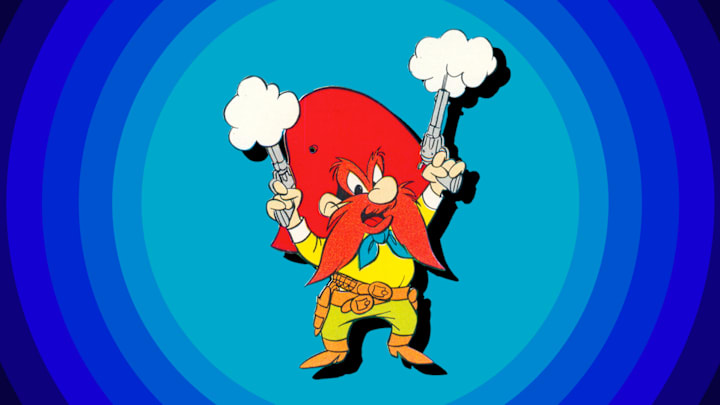There are plenty of ways to convey incredulity and confusion in just a few words. What in the world?, What on Earth?, and What the heck? all do the trick, as do a couple other less kid-friendly iterations of the expression. But when it comes to sounding like a pistol-toting, Stetson-wearing outlaw, none of those options can compete with What in tarnation?.
So, what exactly is tarnation?
The Meaning of Tarnation
The phrase What in tarnation? isn’t, as some people assume, a truncation of What in the entire nation?. Tarnation is basically just a gentler version of damnation, much like heck is to hell and darn is to damn. According to the Oxford English Dictionary, tarnation grew out of two terms: darnation, a natural variant of damnation; and tarnal, a pronunciation of eternal that was used as a mild curse. You might say “That tarnal cat!” in the same way that you’d say “That darn cat!” You could even say “That tarnation cat!,” as tarnation also worked as an adjective and adverb.
Though we generally associate tarnation with the Wild West, it wasn’t confined to that era (or region). The earliest reference to the term in writing is from a 1787 play called The Contrast: A Comedy in Five Acts, written by Royall Tyler and set in New York City. The play, often cited as America’s first theatrical comedy, satirized two notable sects of American society: the preening, snooty Europhiles and the hardy, honorable patriots.

The character who uses tarnation—and tarnal and tarnally—is Jonathan, a manservant who functions as a caricature of working-class New England Yankees. Think of him as The Contrast’s Kenneth Parcell (of 30 Rock). Jonathan usually says “Tarnation!” as a solitary exclamation, but once he does ask another character, “What the rattle makes you look so tarnation glum?” He also mentions “a tarnal blaze,” “a tarnal cross,” “a tarnal curse,” and candles that “smelt tarnally of brimstone.”
In short, tarnation and its offshoots evoked a sense of homespun Americana—and that association continued as Americans migrated westward.
Did Yosemite Sam Ever Say “What in Tarnation?”
Many people consider Looney Tunes’ Yosemite Sam—the hot-tempered gunslinger whose mustache is almost as big as his hat, which is even bigger than he is—to be the poster child for the expression What in tarnation?. But the widespread belief that Sam has always been shouting that phrase could arguably be classified as an example of the Mandela effect: a shared false memory.
We couldn’t find a single instance of his saying the word tarnation in any original Looney Tunes cartoon, starting with his debut in 1945’s “Hare Trigger” and ending with 1964’s “Dumb Patrol.” And even if one did happen to slip by us, that’s hardly enough to earn tarnation (or What in tarnation?) the distinction of being an iconic catchphrase of the character. Far more often can you find Sam yelling “Great horny toads!” or leveling insults at Bugs Bunny—especially varmint (a pesky animal) and galoot (“an awkward or uncouth fellow,” per the OED).
That said, Yosemite Sam did utter the word tarnation on at least a few fairly recent occasions.
- In the 1992 cartoon “Invasion of the Bunny Snatchers,” he says, “Tarnation! Some rabbit’s got his footy prints all over my desert.” (The line is similar to one in 1955’s “Sahara Hare,” in which Yosemite Sam says, “Great horny toads, a trespasser! Gettin’ footy prints all over my desert.”)
- In “Fish and Visitors,” a 2011 episode of The Looney Tunes Show, he shouts, “What in tarnation is a-goin’ on here?” (Bugs Bunny and Daffy Duck are throwing a loud house party.)
- In the 2012 episode “The Stud, the Nerd, the Average Joe, and the Saint,” he shouts, “What in tarnation are you doin’ here?” (He was sleeping through a house fire, which Bugs came to rescue him from.)
- And in the 2013 episode “The Grand Old Duck of York,” Sam shouts “What in tarnation is he doin’ up there?” (Daffy is practicing the piano—loudly and poorly.)
It seems unlikely that these modern references are enough to explain why so many people who grew up watching old Looney Tunes cartoons associate Yosemite Sam with the phrase What in tarnation?. As is often the case with the Mandela effect, there might not be a concrete explanation beyond the fallibility of human memory.
“What we know about false memory is that it arises through the reconstruction process,” Gene Brewer, Ph.D., an associate professor in cognitive psychology at Arizona State University, told Mental Floss in 2019. “When you recall an event, you use memories around it, taking elements or pieces of other events and fitting them where they make sense.”
Read More Articles About Words:
The word tarnation appeared in other popular mid-20th-century TV shows, like Gunsmoke and The Beverly Hillbillies, and it’s possible that we collectively shifted it onto Yosemite Sam because it matched his persona so perfectly.
Moreover, Looney Tunes completionists would’ve heard the term on the program at least once. In 1949’s “Bowery Bugs,” when Bugs Bunny introduces the story of a thrill seeker who jumped off the Brooklyn Bridge in 1886, an old man says with a chuckle, “What in tarnation did he do that for?”
Have you got a Big Question you'd like us to answer? If so, let us know by emailing us at bigquestions@mentalfloss.com.
